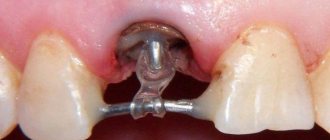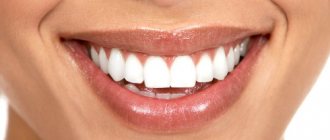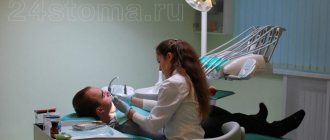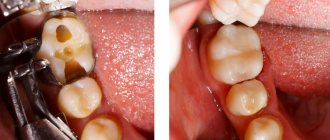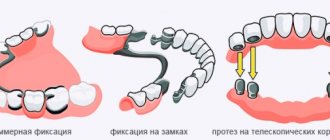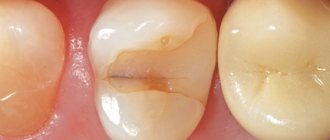Why is the enamel grinding procedure carried out?
Grinding of teeth involves removing a layer of hard tissue (enamel and dentin), so that the orthopedic structure subsequently installed on the “support” looks natural and beautiful, fits tightly, is securely fixed, has stability and strength. This is also done to ensure that microbes do not get under the prosthesis or food debris gets clogged, which together can provoke the development of an inflammatory process.
On a note! Typically, the doctor removes a layer equal to the thickness of the chosen prosthesis. If a crown or bridge is installed, the tooth is ground down to a cone shape. When turning for microprostheses, for example, for veneers, the specialist “cuts down” the enamel in the frontal, lateral and cervical areas.
Often after the procedure, the patient’s gums around the ground tooth hurt, or the prepared element itself ache. Naturally, discomfort does not arise immediately, but after the anesthesia wears off. For some people, discomfort does not appear until several days, weeks or even months later. What is this connected with? We'll figure it out together.
Causes of pain after dentures
All inflammatory processes are accompanied by pain, redness, swelling and dysfunction of the affected organ. However, each pathological process has its own symptoms and cause. For example:
- Incorrect or incomplete preparation of teeth for prosthetics. This means the lack of professional hygiene, root canal treatment, oral sanitation and treatment of chronic foci of infection and periodontal diseases.
- Errors in the choice of design, as well as its manufacture. Incorrect installation leads to the formation of too large gaps between the gum and the prosthesis, or vice versa - to its too tight fit. In the first case, there is a constant accumulation of food debris, inflammation, pain and an unpleasant odor. In the second - the formation of bedsores, with similar symptoms.
- Failure to comply with the rules of operation of the structure and oral hygiene, which entails complications in terms of breakage and damage to the dental structure, accumulation of hard and soft plaque, the development of periodontal diseases and carious processes with its complications.
- Allergy to prosthetic materials. Sometimes such an individual reaction occurs to the residual monomer of the base of removable structures.
Oral hygiene
Any of the above reasons leads to the development of complications, which are often accompanied by toothache after dentures . It can be:
- Caries and its complications – pulpitis, periodontitis, periostitis.
- Acute or aggravated forms of periodontitis.
- Prosthetic stomatitis.
- Mechanical injury to the soft tissues of the oral cavity due to dental structures.
Causes of painful sensations in teeth
1. Physiological response to intervention
This is the most common reason why teeth and gums hurt after grinding for crowns and other orthopedic structures. After all, during the procedure, the specialist acts on the tissue instrumentally and medicinally, touching the nerve endings. This reaction is considered normal.
On a note! If, after grinding teeth, hyperesthesia (increased sensitivity) and aching pain appear, especially during the consumption of cold, hot, sour and spicy foods, and hygienic cleaning, then this often simply indicates a thinning of the tissue area of the prepared unit.
Most often, hyperesthesia after turning occurs on vital, that is, living units where the pulp is preserved. Sensitivity is enhanced even despite the presence of temporary crowns, which, it would seem, serve as reliable protection from external irritants. Temporary structures are fixed immediately after preparation and worn until permanent dentures are created.
Medical errors
If a tooth or gum hurts after grinding, then unqualified actions by the doctor cannot be ruled out. Most often, inexperienced specialists make the following mistakes:
- overheating of the pulp: occurs when preparing tissue with a bur,
- removing too much tissue,
- nerve injury: to avoid complications associated with damage, overheating or inflammation of the nerve under the prosthesis, experienced specialists advise depulping the tooth, that is, first removing the pulp from it.
If the doctor made the mistakes listed above, then the pain makes itself felt almost immediately after the procedure and can persist for several weeks or even months.
3. Development of a pathological inflammatory process
If a lot of time has passed after medical manipulations, and you have severe discomfort and your teeth hurt after grinding for crowns and bridges, then this signals the development of various dental diseases: caries, pulpitis, periodontitis, cyst, granuloma, fistula, abscess, gumboil. In this case, the pain does not go away for a long time, intensifies with each subsequent day, and is poorly relieved by analgesics. Along the way, other alarming symptoms arise: purulent bumps appear on the gums, the gums and cheek swell, the body temperature rises, it becomes painful to chew and press on the causative element.
More often, the problem arises again due to the fault of a clinic specialist who, during the preparation and preparation of tissues before prosthetics, violated the rules of asepsis, did not fully treat (after all, dentures are often placed on teeth destroyed by deep caries and other dental diseases), poorly cleaned and poorly sealed the roots channels. Pulpitis can occur if, in the process of preparing the “support,” the doctor caused irreversible damage to the nerve.
Expert opinion
Andrey Rastislavovich Chernov
Specializations: Orthopedic dentist
Experience: 11+
“Treatment, grinding and prosthetics of a tooth with an orthopedic design is a complex and multi-stage process, in which at least several experienced specialists must take part - a therapist, a dental technician (creates a prosthesis using casts of the jaws), an orthopedic doctor. If everyone has done their job efficiently, then pain after completing all the manipulations should not arise either in the short or long term.”
Sometimes a pathological inflammatory process occurs due to the fault of a patient who systematically violates oral hygiene, does not monitor the condition of installed dentures and surrounding tissues, and receives various injuries.
Why can a tooth hurt under a crown?
Toothache can occur for several reasons, most of which are associated with poor preparation of the tooth for the installation of a crown. First of all, these are errors when filling root canals after depulpation.
Causes of inflammation
Inflammation under the crown can cause:
- Insufficient filling of canals. If the canal is not filled with filling material to the top, the empty space is quickly populated by pathogenic microflora. Its waste products cause inflammation.
- Poor obturation (filling of canals). If the doctor was in a hurry or, due to inexperience, did not fill the canals tightly with filling material, bacteria will settle in the resulting pores, which will ultimately cause inflammation. Crown pain may occur months or years later.
- Perforation of the canal wall. Most often this happens when the doctor mechanically expands a canal with an uneven axis with a rasp. For example, in a curved or bent root. In order to properly seal the canals in such roots without breaking through the wall, a specialist needs extensive practical experience. The doctor may also damage the wall when installing the pin. If the hole is immediately closed with a special material, there will be no complications. But if the doctor simply fills the canal without closing the “gap,” problems may arise. The filling material is not completely biocompatible with the periodontium - the connective tissue surrounding the root. If, through the resulting hole, it extends beyond the canal, the periodontium becomes inflamed. A complication of the inflammatory process can be a cyst or granuloma.
- A fragment of an instrument in the canal cavity. Unfortunately, this is a common occurrence. The instrument may break due to improper use technique, and this will be the doctor’s fault. Or due to the physiological characteristics of the root. For example, if it is strongly curved and difficult to pass. In this case, the specialist is not to blame. The main problem in such situations is that it is often impossible to remove the tool fragment from the canal. But no matter why the foreign body ended up in the canal, it can cause inflammation, even if the canal is sealed.
- Pulp burn. This happens when a crown is installed on a living (non-pulpless) tooth. During turning, the specialist must strictly adhere to the protocol. In particular, use water cooling and prevent tissue overheating. If the doctor does not adhere to the protocol and is in a hurry, the dentin overheats from the friction of the bur and “burns” the neurovascular bundle hidden underneath it. As a result, the pulp becomes inflamed, the tooth reacts to cold and hot, and acute pain may occasionally occur, turning into aching pain.
- Poor quality crown installation. For example, the denture does not fit well; there is a gap between the crown and the tooth. Another possible mistake is that the ledge for seating the prosthesis is made too low; the crown puts pressure on the gum and causes inflammation. In this case, the patient may feel that when pressing, the tooth hurts under the crown.
Why does my gum hurt?
Sometimes the teeth do not react at all, but the gums hurt after grinding. Let's list the reasons for this:
- physiological reaction to an anesthetic injection,
- gum retraction: in order to qualitatively fit the prosthesis to the soft tissues and eliminate discomfort during operation, as well as to create a highly accurate design that fully corresponds to all the anatomical features of the patient, before taking impressions, specialists widen the periodontal sulcus. For the procedure, special threads are most often used, which are inserted under the gum and lift it. Such manipulations lead to the fact that the gums then become slightly inflamed and swollen, and also hurt for several days,
- individual reaction of the patient and allergies to the medications used during the grinding process: in this case, the gums may itch and itch, a rash appears on them,
- traumatic gingivitis and periodontitis: if in the process the specialist damaged the gums, then the patient experiences persistent aching pain, swelling and bleeding of the mucous membrane. As a rule, it all starts with gingivitis, but if the disease is neglected, it is complicated by periodontitis.
Methods for fixing a crown
In modern dentistry, a crown is placed in 3 ways
.
Installing a crown on a pin
If the tooth root is not destroyed and is healthy, then a pin is placed inside. It is easy to install; before installation, the doctor gives an injection with an anesthetic.
The pin is placed in the tooth socket and secured with special solid compounds.
A crown prosthesis is installed on the pin itself.
It is also possible to restore a tooth without a pin using CEREC technology.
Fixing the prosthesis using a tab
A stump inlay is a cast stump of a tooth with a root part.
When installing a crown, the same method is used as when installing a pin. The dentist makes a hole in the tooth, and the root part of the inlay is placed into it. Next, a crown is put on it, just like, for example, on a living tooth ground before the procedure.
Implant supported crowns
A fixed prosthesis lasts much longer than a removable one; it is more reliable and durable. To install such a prosthesis, you need the strongest possible fixation on the patient’s tooth.
It is not always possible to save the root of a tooth; in order to install a crown on an implant, the tooth is removed.
An implant is installed in place of the removed unit. The implant material can be different, it all depends on the budget. It can be titanium or ceramic (zirconium).
Outwardly it resembles a small bolt that needs to be screwed into place of the removed tooth root.
The third installation option is the longest and most expensive, but the patient actually receives a new tooth that will not be susceptible to caries, destruction and will not hurt.
Preparation before installing a crown
In order for the crown to fit tightly to the tooth, it must be ground. The procedure is quite painful, so the doctor will use an anesthetic.
The degree of turning depends on the thickness of the crown, as well as what material is chosen.
In most cases, the nerve of the tooth is removed because it can be burned during the grinding process.
Removal of the nerve involves cleaning the canals and their sanitation. If the removal of pulp or the cleaning of the canals was of poor quality, then pain may appear under the crown.
A tooth under a crown can hurt for various reasons. We will talk about them further in the sections of the article.
After grinding, an impression is taken from the tooth, and a plaster model is made from it in a special laboratory. The prosthesis is cast along it.
While the prosthesis is being made, the patient is given a temporary onlay for the tooth. After all, during the period of turning it becomes more sensitive. The temporary structure is made of plastic and placed on temporary cement.
When installing a permanent implant, the old structure is removed, the remaining cement is cleaned off and a new crown is secured.
This is called fitting it in, only if the patient does not complain of pain in the tooth under the crown, the gums do not hurt, and nothing interferes, then the structure is placed on an already strong, durable composition.
There is no way to remove it. To remove such a crown, the tooth will have to be sawed into two parts.
When should the crown be removed?
You should not carry out this procedure yourself; it should be done by an experienced dentist.
The crown is removed if there is deformation, chips, or cracks.
When the service life has already expired.
If there is pain under the crown, it gets worse from time to time.
Methods of tissue trimming: after which procedures pain occurs more often
There are different ways to prepare tissue. According to experts, after grinding the teeth, some of them may actually experience aching pain. But other methods, on the contrary, are considered gentle, and therefore do not cause discomfort at any stage of treatment and prosthetics.
Using a diamond-tipped bur
The drill, despite the loud, annoying sound, is still popular among dentists, because with its help you can quickly and efficiently carry out work of any level of complexity and scale, and grind off any amount of tissue.
It is boron that is most often used for preparing tissue for crowns and bridges, and for turning teeth for veneers. During the process, the doctor uses the device at different speeds so that it does not cause overheating of the tissues and pulp; at the same time, a cooling liquid is supplied to the oral cavity. Despite all the safety measures, many patients note that it was after using boron that they experienced pain.
Via ultrasound
Situations where a tooth hurts after grinding performed using ultrasound are quite rare. The method is characterized by a more gentle effect, compared to boron[1], allows you to process fabrics carefully and without contact, and does not cause overheating. However, ultrasound can still cause discomfort and short-term increased sensitivity of hard tissues and gums in people with a low pain threshold and weakened enamel.
The method is used if you need to remove a small amount of tissue.
Laser method
Here, a laser is used for preparation, which, like ultrasound, acts in a targeted and non-contact manner. The method is considered one of the safest and most painless[2], suitable for people with sensitive gums and mucous membranes, and does not cause pain or discomfort. The laser not only carefully grinds the tissues, but also disinfects them, promotes rapid healing, and prevents bleeding.
Water-abrasive treatment
Suitable only in cases where a minimum amount of tissue needs to be removed. During the process, a specialist treats the enamel with a stream of water containing abrasive particles. After such grinding of teeth, aching pain and any discomfort are completely excluded.
On a note! Until recently, dentistry also used a chemical method, where tissues were first softened using chemicals and then removed with an instrument. However, today this method is recognized as traumatic and very dangerous for the nerve of the tooth.
Why does a tooth hurt under a crown and what to do about it?
The crown is the most popular type of prosthetics in modern dentistry.
Today, several types of prostheses, materials and installation tactics are used, thereby minimizing the risk of complications. However, there are cases when prosthetics are completed, the crown is installed, and after some time the tooth becomes sore under the crown.
Why does the tooth under the crown hurt and what to do about it?
It is difficult to find an exact answer to this question, since there are many reasons that can provoke pain syndrome after crown placement. However, the symptoms and types of pain will also be different. In any case, you should hurry to meet with your dentist.
Let me immediately note a situation where tooth pain under the crown occurs immediately after installation of the structure; there is no need to panic; most likely, the pain will subside within 2-3 days. This is due to the adaptation of tissues to the new structure in the oral cavity.
However, if a tooth begins to ache under a crown that was installed quite a long time ago, this is a reason to visit a doctor as soon as possible.
There are several common reasons why a tooth hurts under a crown.
- Deep caries.
- Pulpitis is inflammation of the neurovascular bundle of the tooth.
- Periodontitis is an inflammation of the periodontium - the tissues connecting the cement of the tooth root and the bone tissue of the alveoli. Chronic inflammation is characterized by resorption of bone tissue from small sizes to the formation of granulomas and large cysts.
- Gingivitis is inflammation of the gums around a tooth.
- Periodontitis is inflammation of the periodontium - the tissues surrounding the tooth and holding it in the alveolus.
The inflammatory process and its symptoms, in particular when a tooth hurts under the crown, does not develop without reason. It is preceded by:
- A loose fit of the crown, when food particles and bacteria get into the gap between the prosthesis and the tooth, the carious process and its complications begin - if the nerve in the tooth is preserved, pulpitis develops, if not, then periodontitis. In addition, in both cases the gums may become inflamed or periodontal pockets may form.
- Incorrect canal filling. Complications such as incompletely sealed or perforated canals, as well as fragments of instruments remaining in the canal, can lead to an inflammatory process in the periodontal tissues, as a result of the proliferation of pathogenic flora in the root canal.
- Insufficient oral care, when hygiene rules are not followed, the carious process develops much faster. Unrecognized at the very beginning, it progresses and can lead to the loss of the tooth along with the crown. Excessive dental deposits are always the cause of gingivitis and periodontitis. Deep periodontal pockets can cause premature tooth loss.
- Too much stress on the tooth, for example due to missing adjacent teeth. This causes chronic inflammation and loss of tooth attachment; the tooth appears normal from the outside, which is misleading to the patient. As a result, overload can also lead to tooth loss.
- Failure to attend scheduled preventive examinations - a patient with crowns installed on his teeth, if he wants to preserve them, must visit a dentist once every six months for preventive purposes, and if there are alarming symptoms, he must immediately contact a specialist. Otherwise, consequences cannot be avoided.
If a tooth hurts under a crown, you should not ignore the symptoms, “drown out” the pain with painkillers and “get treatment on the Internet.” If you consult a doctor, solving the problem will be much more effective. After all, as we have figured out, there are many reasons why a tooth under a crown may hurt, and first you need to carry out a diagnosis.
An X-ray plays a key role here; if necessary, a more detailed examination is prescribed - computed tomography. This allows us to determine the main question: a vital (“living”) tooth hurts, a non-vital (“dead”) tooth hurts, or there is a problem with the periodontal tissues. Then the treatment tactics are determined.
If a vital tooth hurts , then everything is usually obvious to the patient.
Therapy is carried out in the usual way. The inflamed pulp must be removed, the root canals disinfected and tightly obturated. Treatment can be carried out both after removing a poorly fitting crown, and through the crown, if its fit is not broken. The issue of crown replacement is decided individually.
If the cause of pain is in the tissues surrounding the tooth , then treatment is aimed at relieving inflammation. Removal of dental plaque, medicinal treatment of soft tissues, cleaning with the “Vector” device, and curettage of the periodontal pocket if necessary are carried out. In this case, crown replacement is always required, since it is the one that causes inflammation. Namely: deformation of the crown, discrepancy in size, for example, the edge of the crown overlaps the gum or, conversely, does not significantly reach it. Traumatization of soft tissues and their inflammation occurs, after removal of which the crown is replaced to avoid relapse.
And now we come to the most interesting part. Can a devital (“dead”) tooth under a crown hurt? Most patients are under the misconception that if there is no nerve in the tooth, then there is nothing to hurt there. And this is the most common misconception and at the same time the most common problem.
the cause of chronic inflammation in the area of the tooth root and the prerequisites for it earlier. If a devital (“dead”) tooth under a crown hurts, the tactics may be different. Such a tooth can be treated either therapeutically or with a combined method of therapeutic canal treatment plus apical surgery. In the worst case scenario, the tooth will have to be removed. The choice of treatment tactics is determined based on symptoms, anatomy, and the previous method of treating a given tooth. But the key in this matter is, of course, the size of the inflammation. Therefore, for a more accurate diagnosis, especially if the question is whether to save the tooth or remove it, a computed tomography is performed.
According to the results of x-ray diagnostics, if the diameter of the lesion is insignificant, then the chances of saving the tooth increase significantly. Next, the doctor will evaluate the possibility of root canal retreatment.
The presence of a pin and the patency of the root canals play an important role here, since if it is not possible to qualitatively unseal, disinfect and tightly obturate the root canals, the success of the treatment is called into question. Treatment is usually long-term and takes several visits to the doctor.
In this case, the doctor will warn you that there cannot be a 100% guarantee for treatment. However, in case of successful treatment, a crown will be re-installed on the tooth and it will be possible to save it.
For the anterior teeth of the upper jaw, combined treatment tactics are often used. Therapeutic retreatment of the root canal is carried out, and then the dental surgeon performs a minor operation - resection of the root apex along with the granuloma. After complete healing, the tooth is restored with a new aesthetic crown. The prognosis for the tooth with successful treatment is also favorable.
Unfortunately, if the focus of inflammation is of significant size, neither therapeutic treatment nor apical surgery will be successful, and such a tooth will have to be removed, but the focus of inflammation is removed along with the tooth, and subsequently, after healing, an implant can be installed in place of the missing tooth, preserving chewing efficiency.
If the tooth under the crown hurts badly and the gums are swollen, and even more so in cases where there is swelling of the cheek, I think no one will delay a visit to the doctor. Indeed, if left untreated, swelling can develop into serious complications! Even if the symptoms subside, a relapse is inevitable, and after a while a fistula may form on the gum. This happens because the pus accumulated at the apex of the root requires release - after its outflow is established, the symptoms may subside, but this does not mean that the disease has passed. The infection has not gone away. The disease will simply occur with periods of exacerbation and remission and at the same time constantly progress, exposing the bone tissue surrounding the tooth to destruction. Such foci of chronic infection will sooner or later make themselves felt, and with a high degree of probability such a causative tooth will have to be removed.
Don't let the problem get so complicated. Only a dentist can understand the causes of pain in a tooth under a crown and provide assistance appropriate to the situation. And in order to save a tooth, with a crown installed on it, and not only, you must follow a number of simple rules:
- carefully observe personal oral hygiene;
- regularly visit a dentist for preventive purposes;
- perform professional oral hygiene;
- perform X-ray examinations at intervals prescribed by your doctor so as not to miss foci of chronic infection;
- timely change failed orthopedic structures.
Toothache is the most severe and unpleasant - this is a well-known fact. Teeth with or without a crown, “living” or “dead”, can hurt, and there are many reasons for this. But to the question: “what to do?” There is only one answer - contact a specialist. Take care of yourself and your teeth.
How long does the discomfort last?
Many patients are interested in how long their teeth can hurt after grinding. Normally, the unpleasant sensations disappear after 3-7 days. This is the case if the preparation was carried out without removing the nerve, or immediately after depulpation.
According to many experts, long-depulped teeth that have been ground should not hurt at all. If discomfort occurs, it goes away after 1-2 days.
When tissues and nerves are overheated with boron, increased sensitivity can persist for several months. But in any case, pain that intensifies and does not go away for more than one week should be a reason for a visit to the dentist.
What measures to take at home
When your teeth and gums hurt after grinding, it is important to know what to do in this situation. Usually, to quickly eliminate the physiological reaction of tissues to intervention, doctors advise performing the following procedures:
- mouth rinse: you can use chlorhexidine solution, Rokotan. Decoctions of chamomile and sage, which have a calming, antiseptic and anti-inflammatory effect, are also suitable. Rinsing is carried out 2-3 times a day,
- applications: if the gums hurt, it is recommended to apply Solcoseryl ointment to it up to 3-5 times a day,
- taking painkillers from a home medicine cabinet,
- following a gentle diet: in order not to further irritate sensitive tissues, it is necessary to exclude solid, cold and hot foods from the diet. It is better to also give up sour, salty, spicy and sweet foods for a while,
- Carrying out oral hygiene as carefully as possible: if your gums and sharpened teeth hurt, then under no circumstances should you stop performing hygiene procedures. However, to minimize discomfort, you can temporarily switch to a brush with soft bristles and a paste with anti-inflammatory components (chamomile, propolis).
Bulb in tooth after crown installation
- home
- For patients
- Interesting
- What to do if your tooth hurts after having a crown installed?
- What to do if your tooth hurts after having a crown installed?
- Interesting
- home
For patients
Why does my tooth hurt after having a crown installed?
- Inflammation of the tooth pulp, if it has not been removed;
- Allergic reaction or caries not noticed during crown installation;
- The crown injures the gums;
- Inflammation of the tooth root;
- An infection occurred during dental treatment;
- The canals are excessively filled with filling material;
- Damage to the crown of the tooth;
- Failure to maintain oral hygiene after prosthetics.
Installation of temporary or permanent crowns is a necessary step after the loss of one or more teeth.
Any dental surgery has a risk of complications, and the installation of dentures is no exception. Pain after crown installation can occur either immediately or after a certain period of time. Regardless of the reason, you must promptly make an appointment with a doctor. Only a dentist can make a correct diagnosis after examining the tooth and taking an x-ray. Pain in the first days after installation of the prosthesis indicates improper preparation for the operation, and in a later period – an exacerbation of chronic processes. Often patients are also concerned about tooth loosening, redness, bleeding and sensitivity of the gums.
Tooth hurts after crown installation: first aid
Only a dental specialist can provide competent assistance, but you should not endure pain and spend a sleepless night. For quick help with acute symptoms, you can use medicines and folk remedies:
- Take classic painkillers from your home medicine cabinet. It may be an analgesic or an anti-inflammatory agent. It is recommended to use the tablets in minimal quantities, as this may affect the effect of the anesthesia in the doctor's office.
- Rinse your mouth with a warm herbal decoction. For the best effect, it is recommended to rinse several times using chamomile, sage, and oak bark.
- Relieve pain with cold - press a towel with an ice cube inside to your cheek.
Solving a problem in dentistry
It is a mistake to believe that there is a norm for how much a tooth hurts after a crown is installed. If you feel unwell, schedule an examination and x-ray with your doctor. If the crown fits poorly, a sharp reaction to eating hot and cold food occurs. In this case, it must be replaced. Another common symptom is pain when pressing on a tooth or the appearance of blood when brushing. The doctor will draw up an anti-inflammatory therapy plan and, if necessary, correct the tooth stump. Pay attention to the period of wearing the crown. When a denture wears out, it can become a problem for your oral health.
Methods for treating a tooth that hurts after a crown:
- replacing a crown that is installed incorrectly,
- carrying out drug treatment: prescribing anti-inflammatory, antibacterial and antihistamine procedures and drugs,
- treatment of the oral cavity, professional cleaning of teeth and dentures,
- cleaning the tooth canals during inflammation, if this has not been done before,
- re-processing the roots.
If there is massive destruction of the tooth under the crown, it will need to be removed. ROMDENT dentists try to find a way out of any difficult situation and save the tooth. If this is not possible, we will offer you alternative methods of prosthetics and implantation. After installing any denture, follow your doctor's recommendations about dental hygiene and regularly check the condition of your teeth at a preventive examination.

